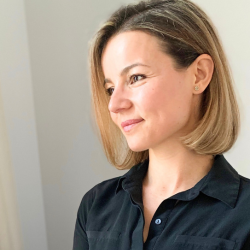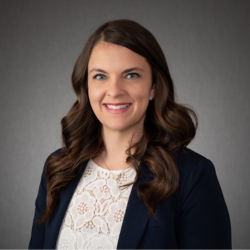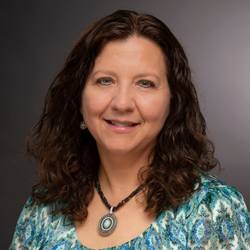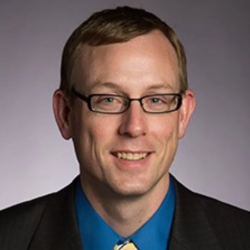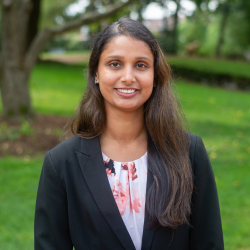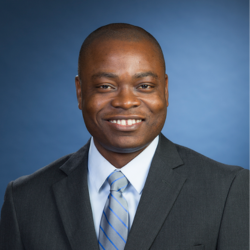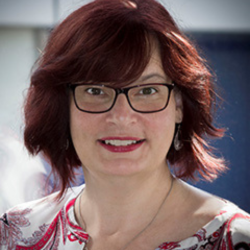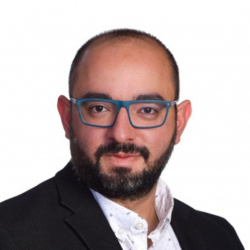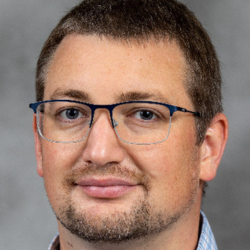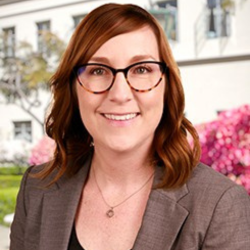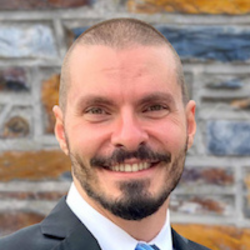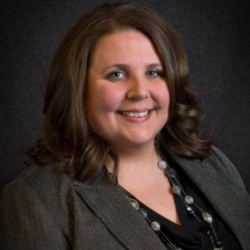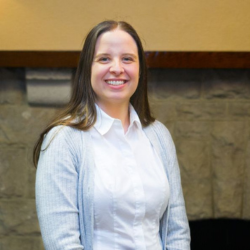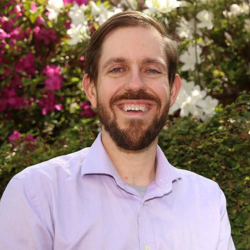Campus KEEN Rising Stars
2023 Edition
Congratulations to the 2023 Campus KEEN Rising Stars!
Campus KEEN Rising Stars are junior faculty who are driven by an entrepreneurial mindset to create long-lasting value, directly impacting the hearts and minds of students, peers, and communities.
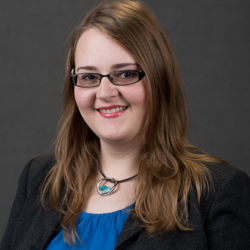 Dr. Anastasia (Ana) Rynearson (Campbell University) joined the School of Engineering as one of its first faculty because of her drive to create high-quality, innovative educational experiences for undergraduates rooted in the Entrepreneurial Mindset. She has used her engineering education background to develop practices and courses across the first two years of the curriculum focused on providing opportunities for students who are mathematically underprepared for engineering.
Dr. Anastasia (Ana) Rynearson (Campbell University) joined the School of Engineering as one of its first faculty because of her drive to create high-quality, innovative educational experiences for undergraduates rooted in the Entrepreneurial Mindset. She has used her engineering education background to develop practices and courses across the first two years of the curriculum focused on providing opportunities for students who are mathematically underprepared for engineering.
Ana works to provide opportunities and support future generations of students who have historically been overlooked and lacked access to educational opportunities that would prepare them for an engineering career.
Cards:
- Using Personas as Holistic, Subjective Assessment Rubrics
- Service and Professional Development - An Integral Part of the First Year Engineering Experience at Campbell
Dr. Asmira Alagic (Saint Louis University) champions EM in the classroom to reshape traditionally one-sided lectures and laboratories into transformational, interactive, student-centered experiences. Above all, she ensures students’ understanding of course materials while emphasizing a whole-student approach to foster educational, personal, and career development.
Asmira sees EM as an opportunity to teach her students collaboration, resilience, and resourcefulness beyond their chemistry courses, implementing multidisciplinary projects incorporating EM between chemistry, engineering, and biology students.
Cards:
- An Electrochemistry Inquiry-Based Project
- Relating metric conversions to real life situations via case studies
Dr. Breigh Roszelle (University of Denver) views entrepreneurial mindset as a basis for the innovation driving 21st century industry across the world. In Introduction to Mechanical Systems, a class that all first-year engineering students take, Breigh incorporated learnings from Integrating Curriculum with Entrepreneurial Mindset 1.0 (ICE 1.0) to use the 3Cs to make the design project in this course more open-ended and value based.
Through her educational research, papers and presentations, Engineering Unleashed cards, workshops she helped organize, and as a liaison with the Office of Teaching and Development, Breigh has been an invaluable resource for her colleagues at the university as well as across the nation.
Cards:
Cindy Tawaf (Rochester Institute of Technology) arrived at RIT with a teaching philosophy directly influenced by her experience of 30 years as an engineer in the automotive industry. She has naturally gravitated toward non-traditional teaching practices that foster deeper student learning. She strives to make her classroom an inclusive and safe place for important conversations.
Cindy has collaborated with the RIT KEEN Leadership Team to promote EML across campus and to help faculty develop teaching capabilities and scale their ideas from small class trials to semester-long endeavors.
Card:
Dan White (Valparaiso University) ensures his students are equipped to handle real-world, needs-driven problems. His teaching method relies heavily on developing curiosity within his students, allowing them to create the connections between concepts and then using those connections to create valuable solutions.
Dan's work with SATNogs and the ARISS-USA Education Committee, where he was a founding member, are efforts that motivate young scholars to consider STEM in general and older scholars to consider space exploration in particular. These and other initiatives that represent his pursuit of innovative opportunities that create real value for others.
Card:
Devina Jaiswal (Western New England University) has cultivated a variety of learning opportunities to create value for her students. For example, while researching methods for bringing the 3C’s into one of her sophomore courses, Devina collaborated with a professor in theatre department to bring the art of storytelling to her classroom via a set of hands-on theatre workshops.
Devina's plans include making EM more sustainable in engineering education. Already, with the EM and micro-EM modules she has developed, there has been a marked improvement in students’ mindset and their knowledge of the subject matter as a result.
Cards:
- Tackling Enzyme Kinetics in a Problem-Solving Studios
- Assistive Technologies for Individuals with Disabilities (AID): Using the Quantified Self to Develop Design Empathy
Gbetonmasse Somasse (Worcester Polytechnic Institute) believes that loosely defined projects are instrumental in helping students develop curiosity, problem-solving, and use an engineering mindset to integrate a range of skills and knowledge that they would not otherwise connect. He also infuses social justice and policy analysis in the curriculum to complement engineering education in the 21st century.
All Gbetonmasse’s classes include active and collaborative learning with a framework of EML. He also advises students off-campus allowing him to use more EML to encourage students to use their entrepreneurial thinking to address societal problems.
Cards:
- Water, M&M, and Basic Principles of Economics
- A Photography Analogy to Motivate Students to Become More Independent Learners
Dr. Jennifer Atchison (Drexel University) introduced Value Sensitive Design to her seniors and first-year students as a way to connect better with the direct and indirect stakeholders of their design project, and uses the ideation toolkit to teach students new skills.
With the latter, Jennifer observed that her position as professor inhibited student creativity. She collaborated with instructors in the School of Education and Neuropsychology to design a mixed methods experiment to investigate this correlation. Based on preliminary results, they are running a full study. They hope to develop interventions to help students feel more empowered to take creative risks.
Jonathan Torres (Bucknell University) is fully immersed in EM as the way to ensure full utilization of every resource available and to discover opportunities. Through multiple touch points, Jonathan introduces entrepreneurial mindset to every mechanical engineering student, initially in the first-year course Graphics for Design and Manufacture and culminating with the mechanical engineering senior design sequence.
Jonathan is an innovator who creates environments to grow skills to create value, encourages connections to design relevant solutions for industry-sponsored projects, and focuses heavily on developing skilled communicators.
Cards:
- Integrated Manufacturing Project
- Printing with Purpose: Learning About 3D Printing Through 3D Printing
Kyle Horne (University of Wisconsin-Platteville) is always looking for opportunities to improve his own teaching methods to improve the value proposition for students in his classes, consistently integrating new ideas. In addition to conventional learning objectives which pull from Bloom’s cognitive taxonomy of function, Kyle writes mindset objectives that align with the 3Cs and reach students in the form of structured reflection activities, improving student understanding of the “big picture."
As part of the KEEN@P Leadership Academy since its inception, Kyle's insight into the science of teaching and learning and motivation have enriched group sessions. This program serves to spread EM as broadly across campus as possible through collaborative change projects.
Cards:
- Mindset Objectives and Reflection Questions for Introduction to Computational Methods
- Truss Analysis Software Development [Python Edition]
Lauren Beverung (Milwaukee School of Engineering) had a steep task to tackle: Making engineering majors find her psychology courses not only meaningful, but connected to engineering. Lauren had to get curious about what her students experienced not only as engineering majors, but as engineering majors in the rigorous, fast-paced MSOE environment.
One of Lauren's greatest sources of innovation stems from learning from her students. While encouraging feedback and fostering open communication, she listens and constantly adjusts her classes with her students’ best interests in mind. Experiential education is a fixture in her classes; Lauren wants her students to be successful engineers as well as successful and compassionate individuals in their communities.
Melissa Gibbons (University of San Diego) has successfully implemented EM-focused projects in her first- and second-year classes, and which are used by multiple faculty in their own classes. One project encourages students to create value for a real customer while considering other stakeholder needs and evaluating economic and environmental costs, and introduces them to renewable energy topics, which aren’t covered in any depth in the textbook.
After having worked as a research engineer for a few years before transitioning to academia, Melissa considers the EM framework to be critical for young engineers to be successful.
Cards:
- Design of a Waste Heat Recovery System: An Open-ended Group Project that Piques Curiosity at the Outset
- Using maker tools in Introduction to Engineering: Designing and prototyping a remote-controlled warehouse transportation system
Rabih Younes (Duke University) has always focused on impactful learning techniques that involve student reflection to make connections between different things they learn and relate them to real-world applications. This motivates students about the topics they are discussing in class, teaching them to realize impactful ideas and create value through their prototypes and products while studying the different impacts of their project. The KEEN framework with its 3Cs amplifies Rabih's approach, giving him a more systematic framework with a variety of tools to better achieve his goals for the students.
Rabih has redesigned his courses so that every topic, activity, project, and case study in his classes has the 3Cs embedded in it. He also aims to have real clients for his class projects, and nearly all his research and mentorship activities revolve around real impactful projects.
Cards:
- Wearable and Ubiquitous Computing Systems Design: A Capstone Design Course
- Metacognition Through a Semester-Long Assignment
Dr. Rachel Kajfez (Ohio State University) always puts her students first in her teaching, knowing they are the primary stakeholders to create valuable learning experiences for. She believes all engineering education research should be actionable and has crafted her research portfolio to allow herself and her students to be curious about research questions that enable student success.
Rachel is always thinking about how her work can be used by others. She approached the development of a 3C assessment toolbox as a student-centered endeavor, focusing on the needs of first-year engineering and capstone courses. To ensure that the assessments were truly creating value, she met with many stakeholders in the programs and regularly adjusted the assessments and their implementation plans to meet the needs of colleagues and their students.
Cards:
- Assessing the Entrepreneurial Mindset through the 3C's: Assessment Toolbox & Implementation Findings
- An Indirect Assessment for Creating Value
Sid Gunasekaran (Sid G) (University of Dayton) knows that all students can learn the technical skills, but it’s their mindset that is the true differentiator of future success. He tells his students that EML is synonymous with learning: When curiosity is piqued, connections are made with other information to yield insights and “aha moments,” and these can lead to value creation.
Rather than summative assessment through exams, Sid employs formative assessment by collecting, reviewing, assessing and providing feedback on all portfolios on a bi-weekly basis. He goes to this extra effort because his experience has demonstrated significantly improved student learning outcomes and he can readily assess the 3Cs by following students’ progression through a problem, project and even over a full course. Nothing makes Sid happier than seeing proof of his students' blossoming EMs.
Cards:
Dr. Somesh Roy (Marquette University) identifies as more than an engineer. He is an artist, a community advocate, an educator, and in his own words, a “historian of soot.” This title welcomes non-engineers to engage in his work more freely, and it broadens the idea of what an engineer can be. It also challenges the notion of what exciting STEM work could be for his students and colleagues: Soot is not glamorous, but by looking through a lens of art, culture, and human history, our communities discover its great value and importance.
Somesh looks beyond the base level of innovation and draws on his other passions to discover new approaches and new partners. Whether partnering with an international artist or looking to apply nursing pedagogy to an engineering classroom, Somesh explores uncommon connections to discover new value for our students, communities, and planet.
Dr. Stephany Coffman-Wolph (Ohio Northern University) believes that instilling the entrepreneurial mindset in students is the way to help them have a “spark” that will inspire them to see themselves as belonging to the profession and, ultimately, to thrive.
Stephany's work has been aligned with the college-wide efforts to infuse the entrepreneurial mindset in the curriculum broadly. She tries to find trying to find real-world or physical representations of very abstract computer science concepts that are also memorable. Classes she designs are full of opportunities to spark curiosity, offering multiple ways for students to demonstrate their knowledge of topics: Concept maps, play-doh representations, comics, poems. Stephany also encourages connections by giving students as much freedom as a project can allow, including tying their project to a field they love. But her greatest impact is by ensuring that students feel valued by her.
Cards:
- Playing in the Sandbox: Developing EM Communication Skills in Introductory Programming Students
- Students Taking Ownership: Creating Artificial Intelligence Videos for Course Material
Todd Fernandez (Georgia Tech) believes that EM is a crucial mindset for his students to develop. Todd integrates this mindset into his teaching by using evidence- and science-based reasoning to create learning experiences that achieve a specific learning goal in an explicit and intentional way.
Todd has focused most recently on three teaching principles: reflection, putting engineering in real-world contexts, and building trust between him and his students. He encourages student self-assessment and self-correction, rewards reflection as part of a grade, and creates an environment that embraces evidence-based approaches to learning. These practices heavily emphasize and helps students build the habits of being curious, creating connections, and using their skills to create value for others. Todd's innovative teaching practices, research, and faculty development initiatives have significantly impacted the institution and the network.
Cards:
- Designing Your Life - The book club
- Georgia Tech: Building Entrepreneurial Mindset Through Story-Driven Learning
Dr. Trevor Fleck (Baylor University) always seeking to improve his teaching skills and has used the KEEN model to do so. He developed a hands-on design challenge in his additive manufacturing course that helped students understand the process and think about additive manufacturing in a commercial sense.
Trevor engages with his peers and professional communities through his research community. He reviews journal articles for high-profile journals, has served as the session chair for the 3D Printing and Additive Manufacturing at the Automotive Composites Conference, and uses his new knowledge on additive manufacturing to improve his classroom presentations and his additive manufacturing project. His passion for the subject and deep knowledge of the topic is imparted to his students, helping them move forward in their own pursuits.
Card:
